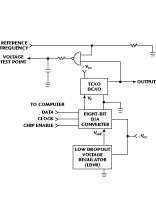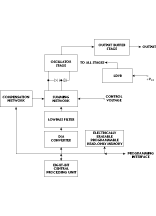The Age of the Precision Oscillator:
The Role of the TCXO and DCXO
Bill Jennewein
M-tron Industries Inc.
Yankton, SD
The need for quality, high precision timing devices is increasing daily. The heart of all communications is linked directly to a stable and dependable source of frequency control. Computer networks, data switching and transmission systems, the Global Positioning System (GPS), test instrumentation, and wireless and RF communications systems all rely on precise frequency control at some point in the system. In addition, with the requirements for precise frequency control come other concerns such as aging and phase noise. Today's telecommunications networks must handle millions of data transmissions over great distances within congested systems. Signal degradation due to noise and propagation delay is of major concern to system designers.
For decades, quartz-based timing devices have been used for applications requiring precise frequency control. Through the use of temperature-compensating networks and ovenized crystal units, 0.01 to 0.1 ppm precision has been achieved easily. While these means of precise frequency control have proven to be effective, they are not without some shortcomings. Many of the designs necessary to achieve the tight stability required involve large packages, mechanical trimmers and high power consumption.
The TCXO
Today, the design of temperature-compensated crystal oscillator (TCXO) products is a bit more refined in that the mechanical trimmer has been replaced with a voltage-tuning capability. The hermeticity of the oscillator package is maintained by removing the internal mechanical trimmer. The access hole in the package of a mechanically tuned TCXO provides a means of ingress for moisture, entrapment of flux residue and solvents, and other atmospheric contamination. External voltage tuning provides the same precision as the mechanically trimmed devices without jeopardizing the hermeticity of the oscillator package.
Voltage tuning also allows for improved aging characteristics for the oscillator.  Tuning is accomplished by using a potentiometer connected to the supply voltage Vcc and ground with its adjustable arm connected to the control voltage pin Vc of the oscillator. Figure 1 shows a typical voltage-tuning circuit for use with voltage-tuned TCXOs.
Tuning is accomplished by using a potentiometer connected to the supply voltage Vcc and ground with its adjustable arm connected to the control voltage pin Vc of the oscillator. Figure 1 shows a typical voltage-tuning circuit for use with voltage-tuned TCXOs.
 Voltage-controlled devices also can be adjusted using a digital technique, shown in Figure 2 , which makes it possible to remotely adjust the oscillator's operating frequency. Internal mechanically trimmed devices do not allow for this degree of versatility.
Voltage-controlled devices also can be adjusted using a digital technique, shown in Figure 2 , which makes it possible to remotely adjust the oscillator's operating frequency. Internal mechanically trimmed devices do not allow for this degree of versatility.
The temperature compensation portion of a TCXO utilizes a thermistor network to sense the ambient temperature of the oscillator and then pull or trim the oscillator crystal to the desired frequency. (Each crystal used in a TCXO is characterized with regard to frequency deviation over its operating temperature.) The crystal then is matched to the oscillator circuit with the appropriate compensation network for a particular frequency vs. temperature characteristic.  Figure 3 shows a block diagram of a typical voltage-tuned TCXO.
Figure 3 shows a block diagram of a typical voltage-tuned TCXO.
The DCXO
An ovenized crystal oscillator (OCXO) is often used to achieve a stability of less than ±1 ppm. OCXOs exhibit good frequency stability, however, they are typically large and expensive, and consume excess power. An alternate approach to achieving tight stability is to use a digitally compensated crystal oscillator (DCXO). This type of oscillator utilizes conventional analog compensation coupled with digital compensation.
 Figure 4 shows a block diagram of a precision DCXO. The device offers a high degree of stability without excessive power consumption and often can be packaged in a standard 14-pin dual-in-line-compatible package. DCXOs are used for many of the same applications as higher stability TCXOs. DCXO stability in the range of 0.1 to
Figure 4 shows a block diagram of a precision DCXO. The device offers a high degree of stability without excessive power consumption and often can be packaged in a standard 14-pin dual-in-line-compatible package. DCXOs are used for many of the same applications as higher stability TCXOs. DCXO stability in the range of 0.1 to
0.3 ppm is common. Their low power consumption makes the oscillators suitable for use in portable or battery-operated devices.
Conclusion
Because of their high stability, both DCXOs and TCXOs are good candidates for use as precision reference oscillators in test instrumentation, LOs for radio communication equipment and phase-locked loop (PLL) reference oscillators. Currently, TCXO and DCXO designs are available for PLL synthesizers, GPS and other applications requiring a highly accurate time base reference.
Bill Jennewein received his BS degree in technical education/electronics engineering technology from the University of South Dakota/Springfield and his MA degree in adult education from the University of South Dakota/Vermillion. His prior experience includes work at M-tron Industries Inc. as telecom products manager, hybrid products manager, applications engineering manager and product development engineer. Currently, Jennewein is M-tron Industries' senior engineering services manager serving as the lead point of contact for all technical support issues for the company's customers worldwide.
